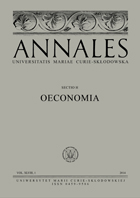Po nitce do kłębka – analiza zmian koniunkturalnych w branży tekstylno-odzieżowej
Following the Thread – Analysis of Fluctuations in the Textile and Apparel Industry
Author(s): Julia Włodarczyk, Paula Małczęć, Kinga PalaSubject(s): Economy, Business Economy / Management, Financial Markets
Published by: Wydawnictwo Naukowe Uniwersytetu Marii Curie-Sklodowskiej
Keywords: branża tekstylno-odzieżowa; klimat koniunktury; rynek tekstylno-odzieżowy;textile and apparel industry; business climate; textile and apparel market
Summary/Abstract: Uzasadnienie teoretyczne: Polski rynek tekstylno-odzieżowy jest jednym z największych i najbardziej dynamicznie rosnących rynków w Europie Środkowo-Wschodniej. Branża ta cechuje się wysoką dynamiką zmian, zarówno sezonowych, jak i obserwowanych w skali cyklu koniunkturalnego.Cel artykułu: Syntetyczna charakterystyka sytuacji w branży tekstylno-odzieżowej w Polsce oraz zmian w niej zachodzących, a także ocena wpływu wybranych determinant na klimat koniunktury w badanej branży.Metody badawcze: W artykule wykorzystano analizę opisową opartą o dane miesięczne dotyczące wskaźnika ogólnego klimatu koniunktury w branży odzieżowej, tekstylnej i obuwniczej w Polsce, opublikowane przez Główny Urząd Statystyczny za okres styczeń 1994 – czerwiec 2020, a także zastosowano model wektorowej autoregresji do oceny wpływu cen, ogólnej sytuacji gospodarczej przedsiębiorstw, ilości sprzedawanych towarów, stanu zapasów towarów, sytuacji finansowej przedsiębiorstw oraz stopy bezrobocia na ocenę koniunktury w badanej branży. Ze względu na ograniczoną dostępność danych z lat dziewięćdziesiątych XX wieku, udokumentowaną przerwę strukturalną (datowaną na styczeń 2006 roku) oraz wybuch pandemii COVID-19 estymację przeprowadzono dla okresu 2006–2019.Główne wnioski: Przeprowadzona analiza potwierdziła wystąpienie zmian strukturalnych zachodzących w branży tekstylno-odzieżowej w Polsce. Okres 1994–2005 cechował się znacznie niższą średnią wartością wskaźnika ogólnego klimatu koniunktury i dużo większą zmiennością o charakterze sezonowym niż okres późniejszy. Wykorzystanie w analizie modelu VAR(12) pozwoliło na stwierdzenie negatywnego wpływu wzrostu cen oraz przyspieszenia wzrostu bezrobocia, jak również pozytywnego wpływu wzrostu ilości sprzedawanych towarów oraz powiększenia stanu zapasów na koniunkturę w branży tekstylno-odzieżowej. Przeprowadzona analiza pokazała ponadto ograniczenia prognozowania w sytuacji nieprzewidzianych szoków, takich jak wybuch pandemii COVID-19. Theoretical background: The Polish textile and apparel market is one of the biggest and the most dynamically growing markets in Central and Eastern Europe. This industry is characterized by high dynamics of changes, both seasonal and at the business cycle frequency.Purpose of the article: A synthetic description of the situation in the textile and apparel industry in Poland and its evolution, as well as the assessment of the impact of selected determinants on the business climate indicator in this industry.Research methods: The article resorts to descriptive analysis based on monthly data on the general economic climate index in the textile, apparel and footwear industry in Poland published by the Central Statistical Office in Poland during the period January 1994 – June 2020, and the vector autoregression model that was used to assess the impact of prices, the general economic situation of companies, sales, inventory, financial situation of companies and unemployment rate to assess the economic situation in the analysed industry. Due to limited data availability for the 1990s, a structural break occurring in January 2006 and the outbreak of the COVID-19 pandemic, the model was estimated for the period 2006–2019.Main findings: Conducted analysis revealed structural changes occurring in the Polish textile and apparel industry. The period 1994–2005 was characterized by much lower values of the general business climate indicator and much greater variability in terms of seasonality than the later period. The use of VAR(12) model allowed to confirm a negative impact of rising prices and faster growth of the unemployment rate, as well as a positive impact of greater sales and increase in inventory on business climate in the textile and apparel industry. Conducted analysis also demonstrated limitations of forecasting in case of unexpected shocks such as the outbreak of the COVID-19 pandemic.
Journal: Annales Universitatis Mariae Curie-Skłodowska, Sectio H Oeconomia
- Issue Year: LV/2021
- Issue No: 1
- Page Range: 101-115
- Page Count: 15
- Language: Polish

